CAGED Part 1: The CAGED System
The CAGED system is a way to look at the fretboard that will allow you to learn scales, chords and arpeggios all the way up the neck. By the end of this tutorial you should be able to construct the pattern for any scale or arpeggio yourself all the way up the guitar neck. This may seem daunting, but by the end of this section I hope you will see that it’s quite achievable.
The system breaks the neck up into 5 positions and you can then learn your scales and other material in each of these 5 positions. This material is a great next step in viewing the fretboard after your proficient in the scales taught in my guitar scales section.
First I’ll detail how the five positions are formed and where they are. We will then look at the major scale in each of the 5 positions. Following this, I’ll show you how to view each of the 5 positions in terms of intervals and how to use this so that you can construct the pattern for any scale or arpeggio in any of these 5 positions yourself simply by knowing the intervals that comprise the scale.
Forming the 5 Positions
5 Open Chords
Lets start by looking at the 5 most common open chords:
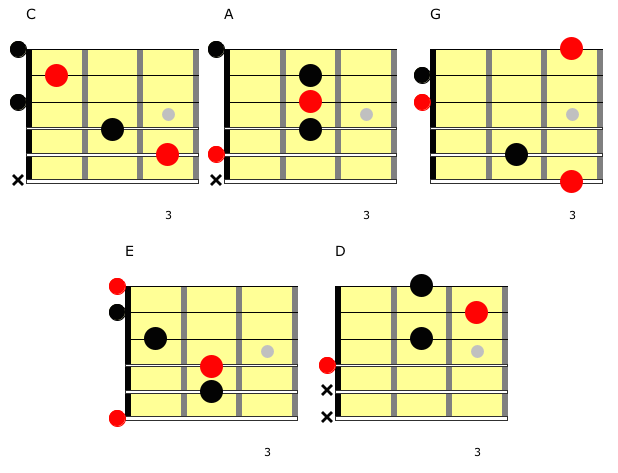
My guess is if your reading this you will already know these chords, but if not you can learn these chords and some other open chords in the open chords section of the site.
The red dot on each of the chords is the root of the chord and will indicate which chord it is. So for example the red dots on the C chord are all C’s on the guitar neck. The red dots on the E chord are all E’s and this is the case for all 5 chords.
Forming Barre Chords From Our 5 Open Chords
The next step is to form barre chords out of each of these 5 chords. This involves moving the chord shape up the neck and using a barre to play what was the open strings in the original chord. If we play these barre chords on the 5th fret we have:
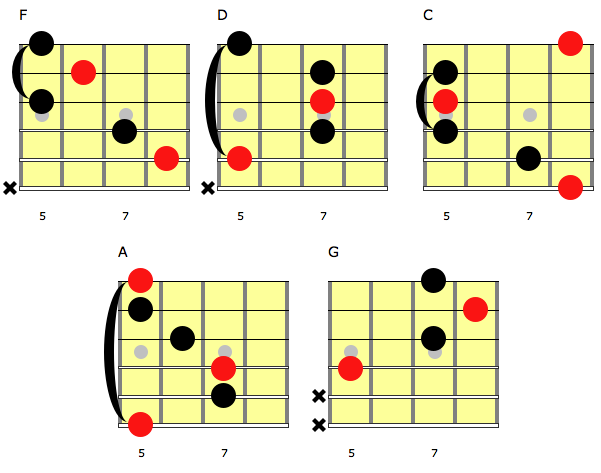
You can see that each of these chords corresponds to one of our original open chords. For example, the A barre chord here corresponds to the E shape of the original open chord. My guess is most readers will be familiar with this chord. Similarly the D chord here corresponds to the shape of the A open chord. You do not need to be proficient at playing all these barre chords. For example the barre chord based on the G open chord is quite difficult. We are looking at this material more to understand how to find the CAGED positions.
Once again, the root notes are in red and occupy the corresponding position that they did in our open chords. As we are now on a different fret the root note will be different than for the open chords above, so for example we have an A chord that uses the shape of the E open chord as the root notes are A’s when played at the 5th fret.
Those of you familiar with barre chords will realise that each of these chords can be played anywhere up the neck. A you move them to a different position, the root note changes and therefore the chord name also changes. For example, using the barre chord formed from the E shaped open chord we could have G, A or C chords on the 3rd, 5th or 8th fret as follows:
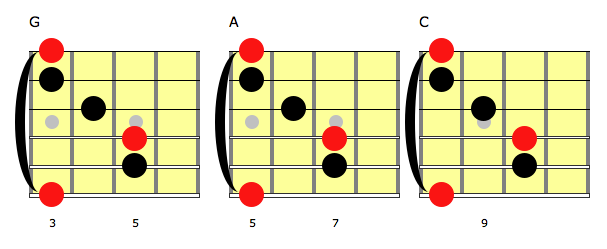
To know what a chord is when it is moved like this you need to know the notes of the fretboard so you can tell what the root note is. I recommend learning this through our guitar notes fretboard trainer.
5 Patterns for Each Chord
Once we’ve gotten this far, we have 5 chord shapes that can be used to form any major chord by moving them up and down the neck. This also means we can play any major chord in 5 positions using a different one of these shapes.
For example, if we are playing a D chord, we can form 5 different D chords in different positions using these 5 patterns as follows:
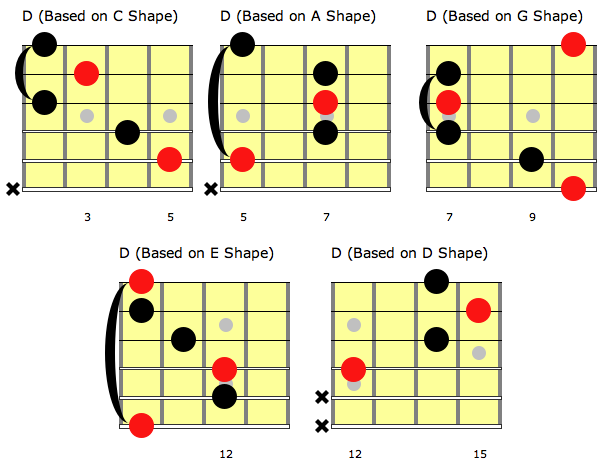
Note that each of these chords is now played in the position up the neck where the red dot, or root note will now be a D, giving us our D chords. This also means that the fret that each of these chords is played at is different for each shape.
These 5 positions are the 5 CAGED positions in the key of D and can be viewed as:
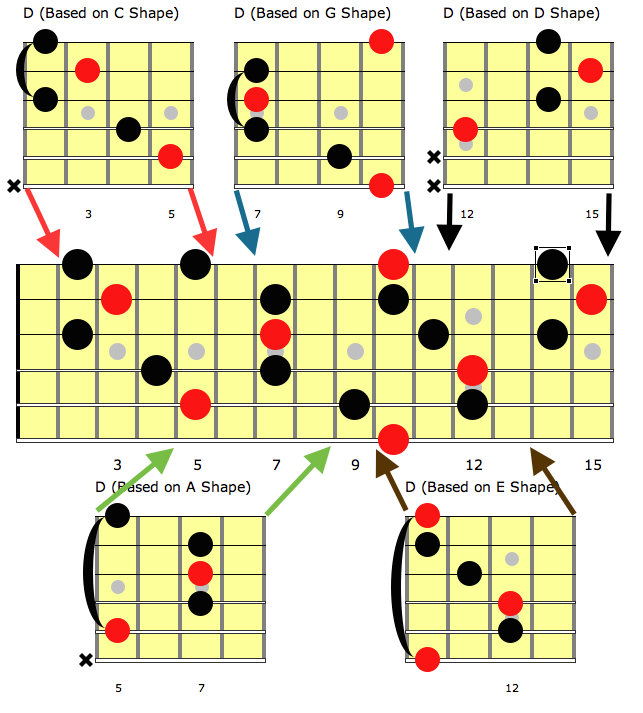
We will name thee positions based on the open chord shape that ws initially used in deriving the position such as the E shaped position, the A shaped position and so on.
To give another example, if we are in the key of B, we can find the 5 CAGED positions by positioning each of these barre chords to be B chords as follows:
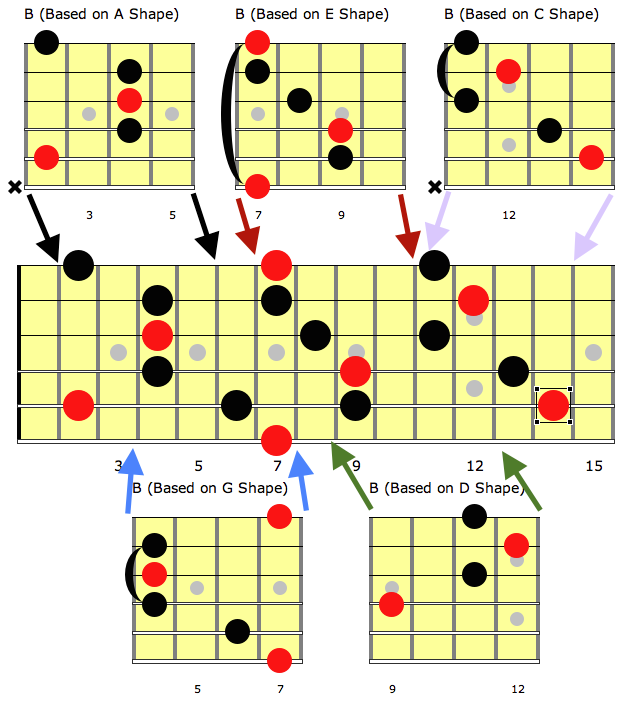
As you can see the fret that each position is played at is different depending on the key. For example, B has the same corresponding CAGED positions as A but located at different frets so the root notes are Bs.
This illustrates how to find the 5 CAGED positions on the fretboard in any key. A few things to note here. The order of these positions is always the same and is the same as in the name “CAGED”. The position corresponding to the C shape is followed by the position corresponding to the A shape, which is followed by G, then E, then D and then back to C again.
Additionally, with the 5 positions, the entire fretboard is now covered. There is no region of the fretboard that doesn’t fit into one of these 5 positions.
Also, using the fretboard trainer to learn the fretboard notes so you can find any given root note on the fretboard will be quite a task in itself. As your learning this you can start to get by through knowing the notes on the bottom 3 strings and finding a position by its lowest root note.
We have used these major chords to find our 5 positions, but you can form any chords, scale or arpeggio in any of these positions. They are not limited to major chords. In order to do this it is useful to view the position simply in terms of the root notes and remove the other chord tones. I the key of D, our 5 CAGED positions with root notes are as follows:
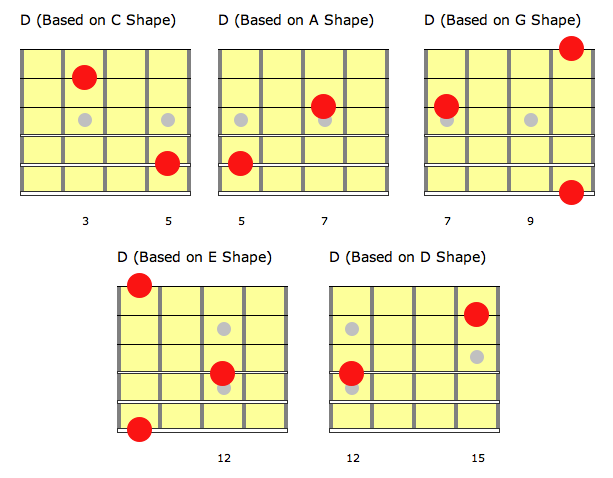
And similarly in the key of B this would be:
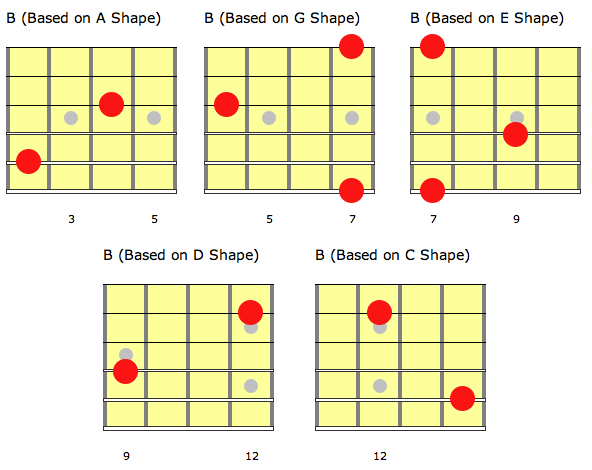
Another way to view these patterns is the position of your hand relative to the lowest root note:
The E shaped pattern has a root note on the 6th string and you tend to play other notes at that fret or higher frets.
The A shaped pattern has a root note on the 5th string and you tend to play other notes at that fret or higher frets.
The D shaped pattern has a root note on the 4th string and you tend to play other notes at that fret or higher frets.
The G shaped pattern has a root note on the 6th string and you tend to play other notes at that fret or lower frets.
The C shaped pattern has a root note on the 5th string and you tend to play other notes at that fret or lower frets.
Finally, these positions are also often referred to by an alternative numbering name as follows:
E Shaped Position: Position 1D Shaped Position: Position 2
C Shaped Position: Position 3
A Shaped Position: Position 4
G Shaped Position: Position 5
In the next section we’ll take a look at the major scale in all 5 CAGED positions.
>> Goto CAGED Part 2: The Major Scale
>> Goto CAGED Part 3: The Intervals

Hello, I see that the patterns do not us eopen strings….how do you know which open strings can be used in a CAGED scale?
If your playing a CAGED scale further up the neck, to know what open strings can be included you would really need to know the names of the notes in the scale and which of these are open strings.
It’s often the case though that when people solo with these scales up the neck they don’t really use the open strings.
From my neophyte perspective… you don’t play open strings at all in caged positions because the barre becomes the equivalent of the open position.
Unless you are playing C A G E or D in the open position,
Hi thanks for this!
Just to confirm, the CAGED pattern only has the root, 3rd and 5th right? Basically just notes from major triad of the key, is that correct?
Is there also a minor pattern as well as for other triads (or maybe even for seventh chords aa well)? Maybe an ADE pattern or something for minor?
Thank you and God Bless =>
You can form any scale or arpeggio in each of the 5 positions around the root notes. This would include the minor triads. The major chords are used here to show how to form the positions and find the root notes you would form other arpeggios around.
Hello, I’m confused. The shape makes sense but I just noticed that the 3rds and 5ths on the low E string are missing. Aren’t they included in arpeggios and chord voicing for the key?
Yes, if you were forming arpeggios based on the positions you would include all the notes. Not all the notes are included in the diagrams here as this is showing how to find the positions based on the 5 common open chords, so only the notes of those open chords are in the diagram.
Thank you for sharing this! Coming from a guy that does not use the caged system, there is a lot of value here for me.
One of the things that I learned from your post is that position 1 is the E chord. Why isn’t the C chord considered position 1?
Thank you!
Do you have a section on your site that explains all of these techniques for the visually impaired like you also have for the modes and scales on the other page
Hi Jason,
Unfortunately, no. The guitar scales article is the only one with a resource like that at the moment.
Is there a chance that you can update this section the same way?
Your section on the scales and modes was so very helpful to someone who is legally blind and loves to play
Thanks
Unfortunately I probably won’t be able to do that at this stage. Theres a few personal issues preventing me from working on the sites content at the moment.
Writing a description of the diagrams in this section would also be a lot harder than in the guitar scales section.
Thats great you found the guitar scales section useful though.